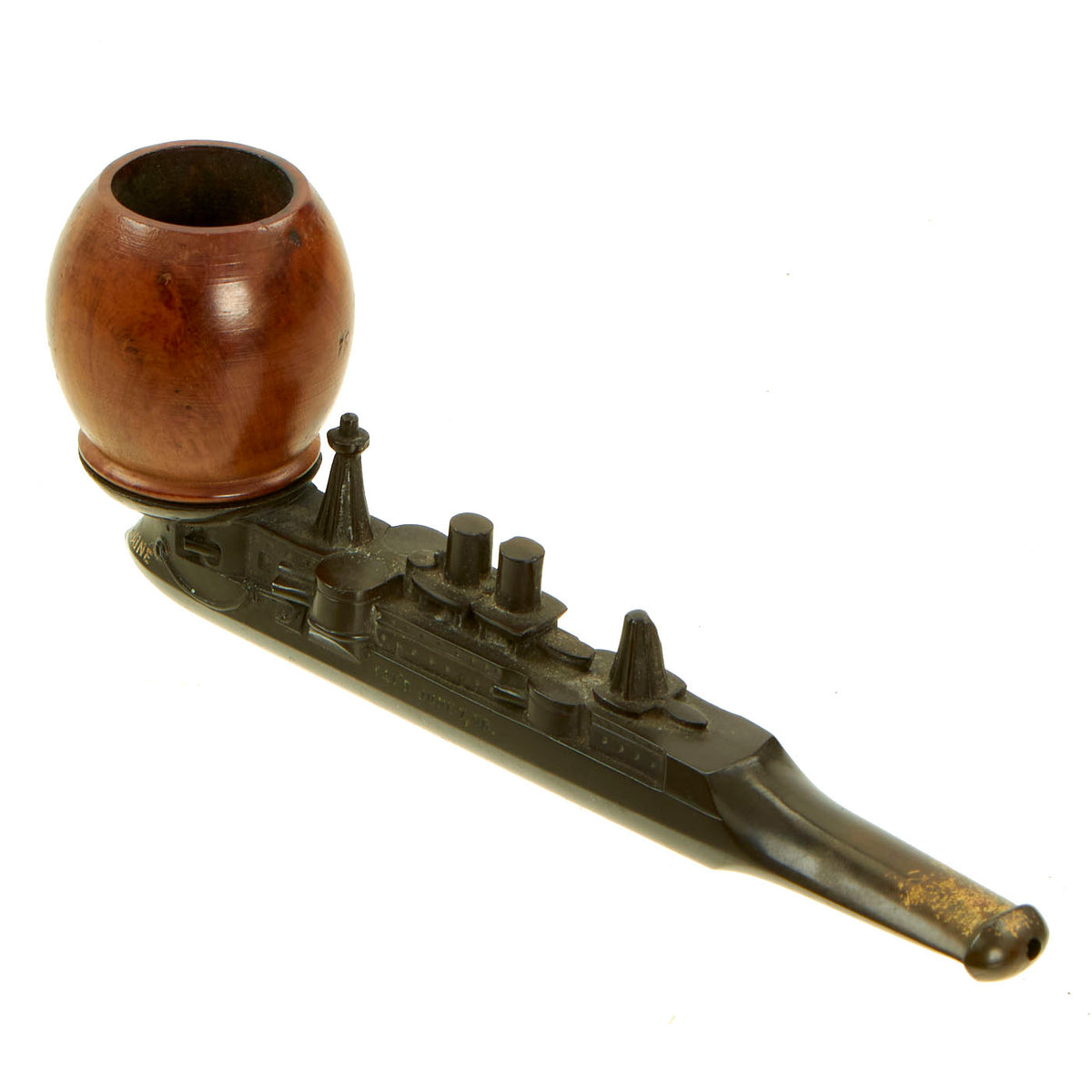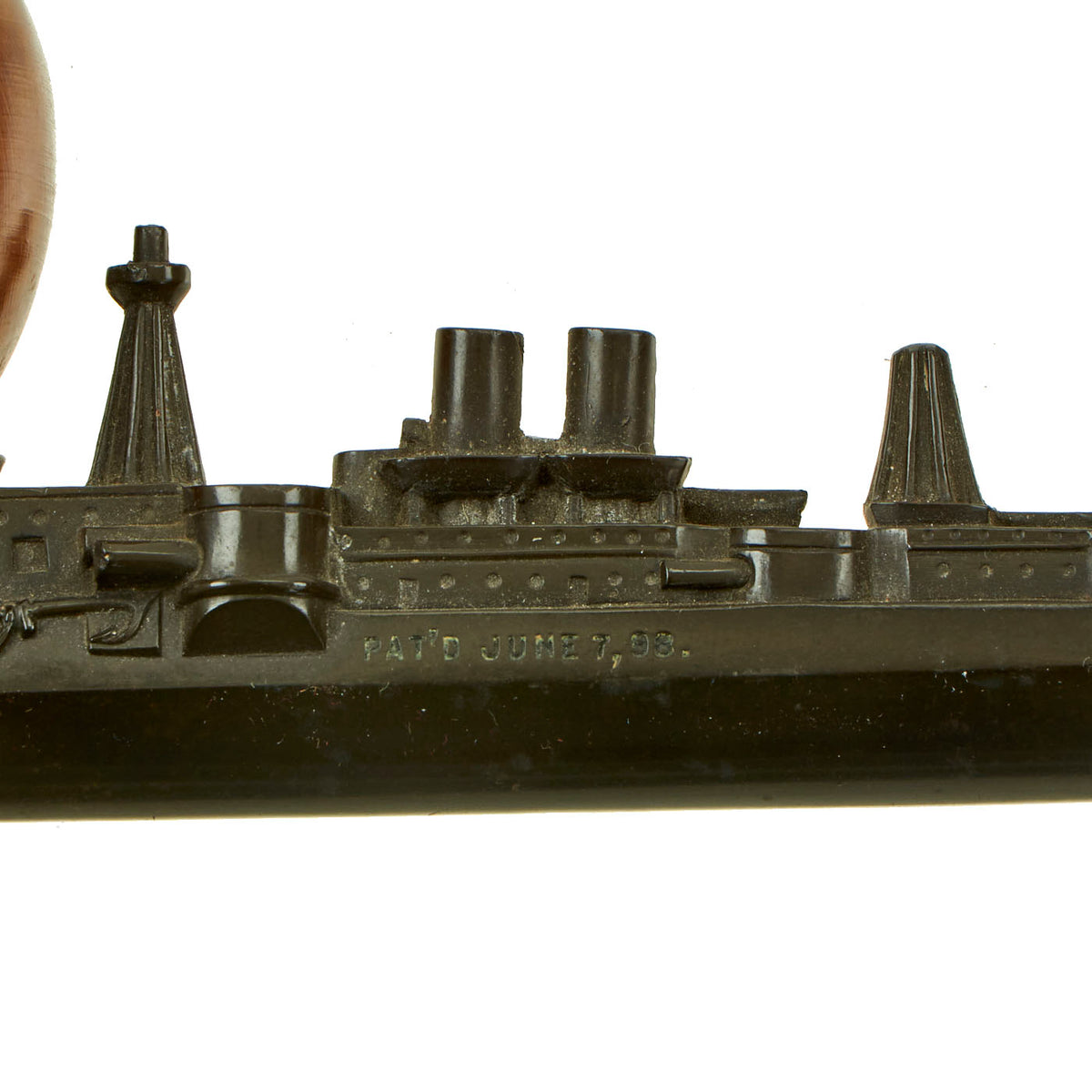Incredible Spanish-American War U.S.S. Maine Gutta Percha Tobacco Pipe- Patented June 7, 1898 Original Items
$ 495,00 $ 148,50
Original Item:Only One Available. This is quite an amazing find! An original Spanish-American War commemorative tobacco smoking pipe in the molded shape of the U.S.S. Maine! We have been in the militaria field for a very long time, and this is the very first one of these that we have ever seen! It is certainly amazing that something this fragile has remained in such impeccable condition over the last 120+ years.
The stem of the pipe is made of Gutta-Percha, an early type of thermoplastic derived from the resin of the Gutta Percha Tree. Gutta Percha was a popular material, especially for making jewelry, during the mid-late 19th century. The bowl is made of carved rosewood and unscrews from the stem. The interior of the bowl shows only signs of light use.
Measures 5 ½” in length x 1 ⅜ “ at the widest point of the bowl.
Gutta-Percha:
Long before Gutta-percha was introduced into the Western world, it was used in a less processed form by the natives of the Malaysian archipelago for making knife handles, walking sticks, and other purposes. The first European to discover this material was John Tradescant, who collected it in the far east in 1656. He named this material “Mazer wood”. Dr. William Montgomerie, a medical officer in imperial service, introduced gutta-percha into practical use in the West. He was the first to appreciate the potential of this material in medicine, and he was awarded the gold medal by the Royal Society of Arts, London in 1843.
Scientifically classified in 1843, it was found to be a useful natural thermoplastic. In 1851, 30,000 long cwt (1,500,000 kg) of gutta-percha was imported into Britain. During the second half of the 19th century, gutta-percha was used for many domestic and industrial purposes, and it became a household word. Gutta-percha was particularly important for the manufacture of underwater telegraph cables.[5] Indeed, it made them possible. It does not degrade in seawater and is a good electrical insulator. These properties, along with its mouldability and flexibility made it ideal for the purpose. There was no other material to match it in the 19th century.The use in electrical cables generated a huge demand which led to unsustainable harvesting and collapse of supply.
In the mid-19th century, gutta-percha was used to make furniture, notably by the Gutta Percha Company, established in 1847. Several of these ornate, revival-style pieces were shown at the 1851 Great Exhibition in Hyde Park, London. The company also made a range of utensils.
The “guttie” golf ball (which had a solid gutta-percha core) revolutionized the game. Gutta-percha was used to make “mourning” jewelry, because it was dark in color and could be easily molded into beads or other shapes. Pistol hand grips and rifle shoulder pads were also made from gutta-percha, since it was hard and durable, though it fell into disuse when synthetic plastics such as Bakelite became available.
Gutta-percha was used in canes and walking sticks. In 1856, United States Representative Preston Brooks used a cane made of gutta-percha as a weapon in his attack on Senator Charles Sumner.
USS Maine:
Maine was a United States Navy ship that sank in Havana Harbor on February 15, 1898, contributing to the outbreak of the Spanish–American War in April. American newspapers, engaging in yellow journalism to boost circulation, claimed that the Spanish were responsible for the ship’s destruction. The phrase, “Remember the Maine! To hell with Spain!” became a rallying cry for action. Although the Maine explosion was not a direct cause, it served as a catalyst that accelerated the events leading up to the war.
Maine is described as an armored cruiser or second-class battleship, depending on the source. Commissioned in 1895, she was the first U.S. Navy ship to be named after the state of Maine.Maine and the similar battleship Texas were both represented as an advance in American warship design, reflecting the latest European naval developments. Both ships had two gun turrets staggered en échelon, and full sailing masts were omitted due to the increased reliability of steam engines. Due to a protracted 9-year construction period, Maine and Texas were obsolete by the time of completion. Far more advanced vessels were either in service or nearing completion that year.
Maine was sent to Havana Harbor to protect U.S. interests during the Cuban War of Independence. She exploded and sank on the evening of 15 February 1898, killing 268 sailors, or three-quarters of her crew. In 1898, a U.S. Navy board of inquiry ruled that the ship had been sunk by an external explosion from a mine. However, some U.S. Navy officers disagreed with the board, suggesting that the ship’s magazines had been ignited by a spontaneous fire in a coal bunker. The coal used in Maine was bituminous, which is known for releasing firedamp, a mixture of gases composed primarily of flammable methane that is prone to spontaneous explosions. An investigation by Admiral Hyman Rickover in 1974 agreed with the coal fire hypothesis. The cause of her sinking remains a subject of debate.
The ship lay at the bottom of the harbor until 1911, when a cofferdam was built around it.The hull was patched up until the ship was afloat, then she was towed to sea and sunk. Maine now lies on the sea-bed 3,600 feet (1,100 m) below the surface. The ship’s main mast is now a memorial in Arlington National Cemetery.
Prompt Shipping and Professional Packaging
We provide a variety of shipping options due to our long-running partnerships with UPS, FedEx and DHL. Our warehouse personnel are well trained and will pack the goods according to our exact and precise specifications. Before shipping your items will be thoroughly inspected and secured. Every day, we deliver to thousands of customers in different countries. This is a sign of our determination to become the largest online retailer worldwide. Both Europe as well as the USA have warehouses and distribution centers.
Note that orders containing more than one item will be subject to a processing period that is based to the particular item.
Prior to shipping the items, our staff will carry out an exhaustive inspection of the products you ordered. Today, most orders will be delivered within 48 hours. The estimated delivery time is between 3-7 days.
Returns
The stock is constantly changing. It's not entirely managed by us since we are involved with multiple entities, including the factory and our storage. Therefore, the actual inventory could alter at any time. It is possible that you will not receive your order after the order has been made.
The period of time is 30 days. Unfortunately, if 30 days have passed since you purchased your product, we are unable to provide a refund or exchange.
The item must not be in use and must be in the original packaging. The item must be in the original packaging.
Related products
Uncategorized
Australian WWII Owen MK1 Machine Carbine SMG Custom Fabricated Replica with Sling Original Items
Uncategorized
Uncategorized
Uncategorized
Uncategorized
Uncategorized
Uncategorized
Uncategorized
Uncategorized
Angolan Rebel 1970s era 60mm Inert Display Mortar from Angolan Civil War Original Items
Uncategorized
Uncategorized
Uncategorized
Uncategorized
Armored Burgonet Helmet & Polearm from Scottish Castle Leith Hall Circa 1700 Original Items
Uncategorized
Uncategorized
Uncategorized
Uncategorized
Uncategorized
Uncategorized













































































